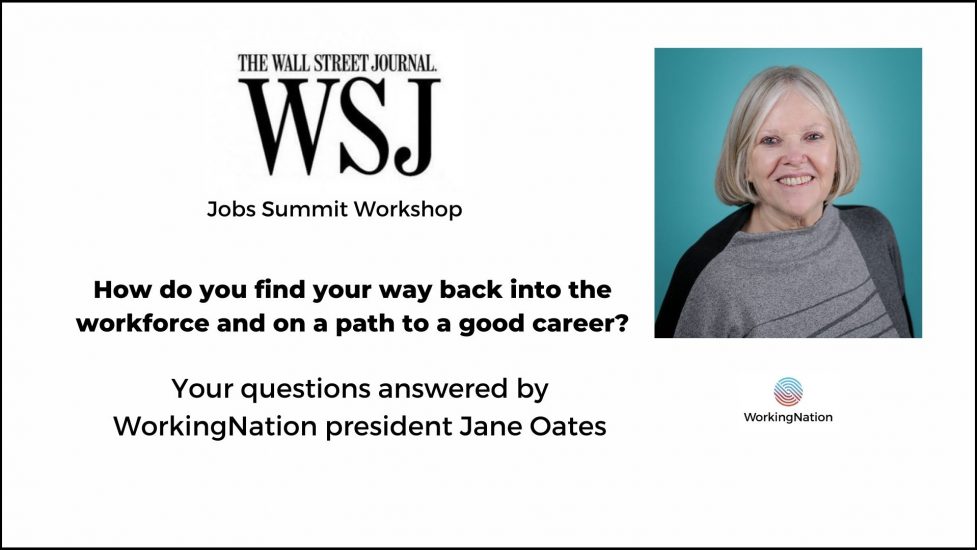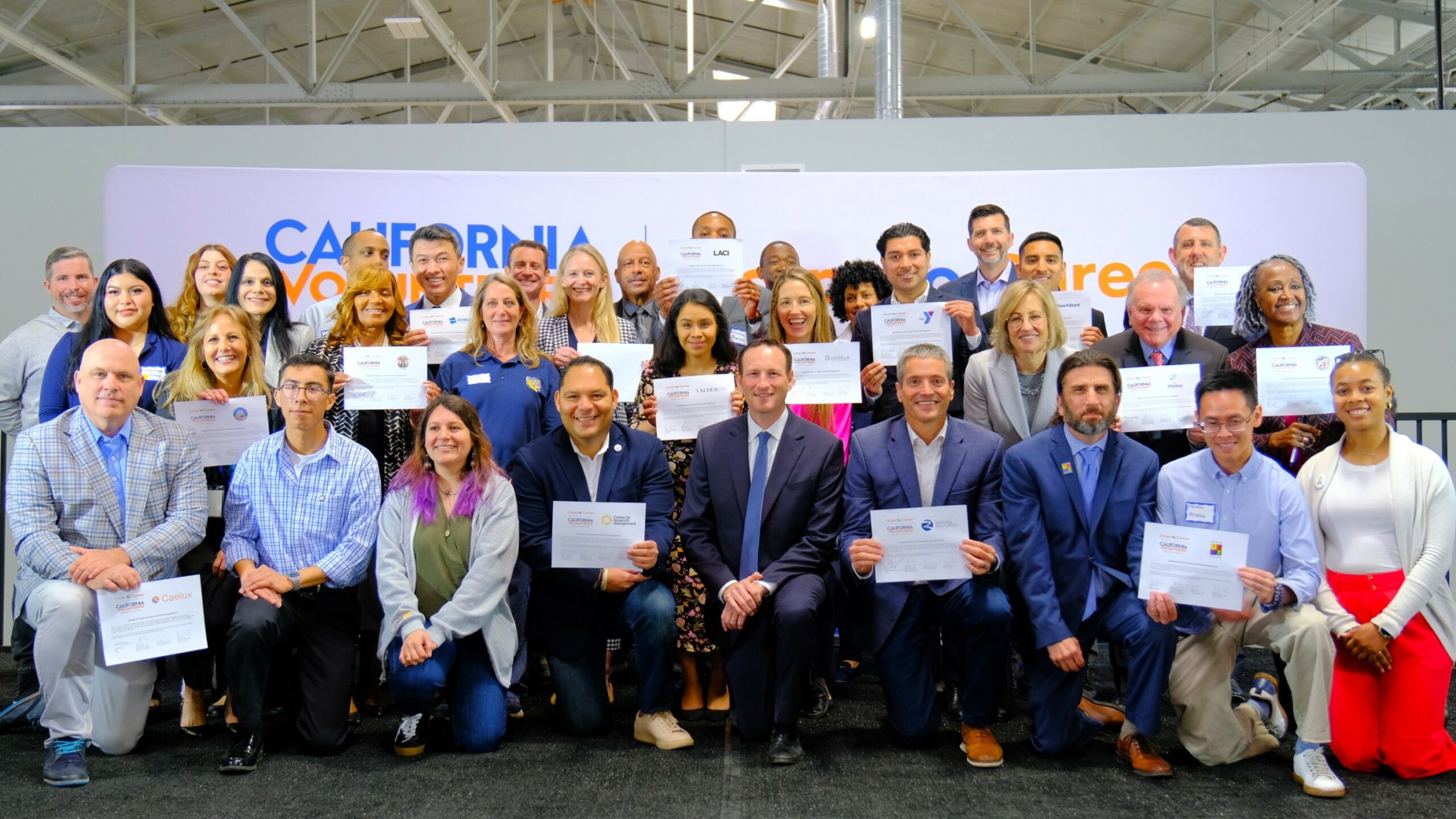Determining next steps when jobhunting can be daunting, whether you’re new to the workforce, looking for a career pivot, or trying to figure out the best way to learn new skills.
Last week, WorkingNation president Jane Oates joined the Wall Street Journal’s Vanessa Fuhrmans, deputy management bureau chief, to discuss strategies and resources during a workshop at the virtual Wall Street Journal Jobs Summit, attended by more than 8,000 people from all across the country.
At the start of the workshop, Oates shared our new WorkingNation animated film FutureProof, which explains how the workplace landscape continues to change at an astoundingly rapid pace. It outlines the important of learning new skills and transferable skills that will pave the way for workers and jobseekers to find new opportunities, including in jobs and careers that haven’t yet been imagined.
Fuhrmans kicked off the questioning by asking Oates what’s positive about this turbulent time as people are making career changes and looking at training opportunities.
Acknowledging the impact of COVID-19 on the country, Oates says, “It’s such a hard time, right? I don’t want to ever gloss over that because that’s the primary thing.”
But regarding job situations, Oates notes, “Getting laid off during a pandemic is a little bit comforting because you have 20 million people with you. Your next employer doesn’t think it was about you. They know it was about the pandemic. It’s a good time to take a deep breath. Think about what you’d like to do next. It’s a great time to prepare.”
Watch the WSJ Jobs Summit workshop now.
Job Training Programs
With many options for training programs, how does someone determine if it will be effective and lead to landing a new job? “The most important thing—ask questions,” advises Oates. “Don’t assume anything. How long will it take me to get that industry-recognized credential or degree?”
Oates says ask about outcomes, as well. “When I’m talking about outcomes, I mean, how many people enrolled in this program? How many people graduated?”
“And then the most important question. Where did they get employed? What kinds of jobs did they get? And I’m clear about this. If someone is not willing to tell you who their employer partners are – where they’re able to place people – walk away from them, I’d take your money and your time somewhere else.”
Credentials and Certificates
One participant asked about the importance of having a certificate in hand versus a list of coursework. “The reason I always gravitate for an industry recognized credential is because in the name, it says that employers recognize it,” says Oates.
“I think it varies job by job. Certainly, some blue collar jobs you need to put the industry-recognized credential that you have. But even when you’re talking about things like data analytics and cybersecurity, if you don’t have something to back that up, how does the employer know that?”
Local Resources
When asked about specific career change coaching or navigating services, Oates says, it’s important to understand the local market. “The best place to start is the public workforce system, your American Job Center or workforce center. Number one, it’s local. They’re going to be the experts on labor market information in your specific area.”
“You’re going to find somebody who can get you the specifics for your area and give you some really good career advice. Wherever you are, you’re within 20 miles of an American Job Center.”
Customizing Your Resume
One participant, with multiple degrees, expressed concern about appearing over-qualified for certain positions. Oates suggests not listing every degree with every resume submission. “Only put the degrees that are relevant to the employer that you’re speaking with.”
She says the same goes for listing job experience on a resume. “Once you’ve been working for a long time, you may have a list of 20 jobs, and you’re only 45 years old. You might want to say, ‘Do I need to list all those jobs?’”
“You don’t want to give the impression that you were a professional student, and you don’t want to work. You would prefer to study. And for someone who has had a lot of different experiences, you want to be able to point out the richness of those experience. So, you may want to cluster them, because you don’t want to look like you’re a job hopper.”
“Ageism is real”
How does the older worker navigate the job market? “Ageism is real,” says Oates. She says it’s not uncommon to leave off dates on a resume, but she notes, “I think people can do the math when they see that you’ve been working in so many jobs.”
“I think you have to take the bull by the horn in everything that you do in your resume and your cover letter. If you’re lucky enough to get an interview, you have to build on what was your past, but make sure that employer knows you’re future-oriented.”
“You want to talk clearly about your accomplishments and your professional acumen from the past, but you really want to customize what you’re saying for that employer – where you want to build and grow with that employer.”
Building Your Network
As a great believer in networking, Oates says, “When you’re looking for a job, you have to network with a purpose. You have to put people in a situation where you’re not forcing them to say the hard thing of ‘I can’t help you find a job.’ Networking means, ‘Give me some advice. Tell me about your experiences. Tell me a little bit about your employer.’”
Oates also says give the contact some information about yourself, beyond “I’m an accountant.” She suggests, “I would instead say, ‘I really have great skills in quantitative reasoning. I’m a great problem solver. I really know how to do things with my hands, whatever it is. Give them a little something about you because they’re networking with you.”
If you’re interested in a specific sector or industry, but do not know anyone at a particular company, Oates says research professional associations.
She cites an example. “Let’s say you want to go in and do backroom functioning in a manufacturing plant. You want to see if you can break into marketing or communications in manufacturing. Go to the National Association of Manufacturers website. See the topics that are interesting to them. That really would be a great way for you to get an insider’s look at that industry.
The websites of professional associations can offer “great insights on what jobs are in demand. Some of them have, as I mentioned, great articles and great speakers, but some of them actually have job boards,” says Oates.
Learn from All Your Experiences
Referring to her first job at 14 at an ice cream bar, Oates says she learned skills that she’s carried through her career. She reminds that everyone has picked up transferable skills along the way.
“Besides the love of ice cream, it taught me people skills. It taught me customer service skills. I think the other thing that resonates with me in every job, it taught me that there’s a great part of every job. I loved the people end of it. I loved giving people what they wanted.”
“But the gritty end of it—cleaning the machine and the wonderful dipped cones, the mess it makes. The cleanup afterwards. All those kinds of pieces of a job are in every job.”
More Answers
There were more questions in the chat, but not enough time to answer them during the Summit. Here are some more of those questions from jobseekers, and Oates’ answers.











